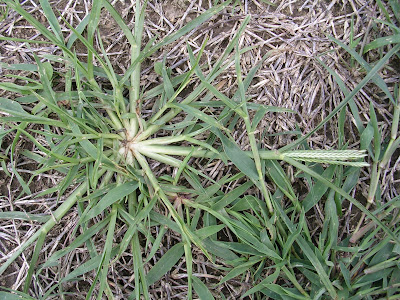Goosegrass
Biology: Goosegrass (Eleusine indica) is an late-germinating summer annual grass that is often found in compacted areas or areas disturbed in the summer. These areas include compacted areas next to sidewalks or cart paths, golf course tees, and areas were soil is disturbed during the summer. Germination typically starts about two to three weeks after crabgrass germinates in early May in most Midwestern States although goosegrass is less common in northern areas of the Midwest like Michigan, Minnesota and Wisconsin.Identification: Goosegrass is a prostrate growing summer annual grass which forms a mat-like rosette. Its flattened leaf sheaths are typically a white to silver color, especially at the base of the leaf sheath. Because of this coloration and its similarity to crabgrass some call it silver crabgrass.
Seedlings develop several leaves (sometimes six or more) before tillering.
As the plants mature they tiller and become very tough and more prostrate in growth (especially in mown turf). Goosegrass produces seedheads from July to September in Indiana. The seedheads are similar in appearance to crabgrass but the seeds are slightly larger than crabgrass seeds and the spikes on the seedhead are often described as being “zipper-like” in appearance.
Furthermore, goosegrass can be distinguished from crabgrass by its leaf arrangement. Goosegrass leaves are folded in the bud (emerge from the sheath as folded) whereas crabgrass leaves are rolled in the bud (emerge from the leaf as rolled).
Furthermore, goosegrass can be distinguished from crabgrass by its leaf arrangement. Goosegrass leaves are folded in the bud (emerge from the sheath as folded) whereas crabgrass leaves are rolled in the bud (emerge from the leaf as rolled).
Cultural control: Reduce soil compaction through aerification and improve turf density.
Biological control: None known.
Chemical control: Goosegrass is best controlled with preemergence herbicides. Herbicides that contain oxadiazon (Goosegrass/Crabgrass Control, Ronstar, Oxadiazon) are the most consistent products for preemergence control of goosegrass. Other preemergence herbicides typically provide less goosegrass control than oxadiazon but can be effective where goosegrass is not too problematic.
Apply oxadiazon at the same preemergence application timing as a normal crabgrass application (the timing varies by location, but it is generally before April 15 in the Midwest). In areas with severe goosegrass pressure, consider a split application approach. Make the initial application at the normal crabgrass preemergence timing at half the rate, and then apply the second (sequential or split) application 60 days after the first.
For postemergence goosegrass control in cool-season turf, use fenoxaprop (Acclaim Extra), mesotrione (Tenacity), fluazifop (Fusilade II), topramezone (Pylex), or MSMA (golf courses and sod farms only). More than one application of these herbicides may be required for postemergence control of tiller goosegrass. Sulfentrazone (Dismiss) is also effective on pre-tillered goosegrass. These herbicides are labeled for specific turfgrass species or are labeled for use in specific areas. Consult the labels and identify your turfgrass species before application.
Postemergence controls in bermudagrass includes foramsulfuron (Revolver) and Tribute TOTAL (thiencarbazone + foramsulfuron + halosulfuron). You can use Fusilade II and Acclaim Extra on zoysiagrass. Fusilade II and Acclaim Extra work best when tank-mixed with 1 qt/A of triclopyr (Turflon Ester Ultra or Triclopyr 4). When controlling goosegrass avoid applications to drought- or heat-stressed turf.
For more information on weed control, search this blog and archived turf tip postings and check out our Turfgrass Weed Control for Professionals Publication.
Aaron Patton, Turfgrass Extension Specialist








Tidak ada komentar:
Posting Komentar